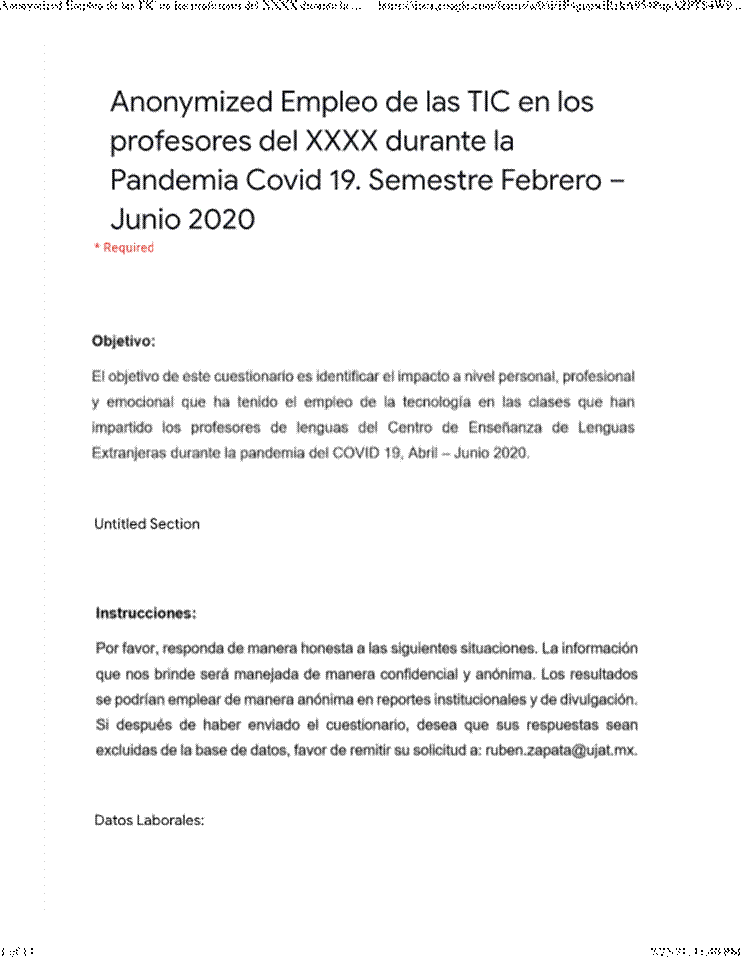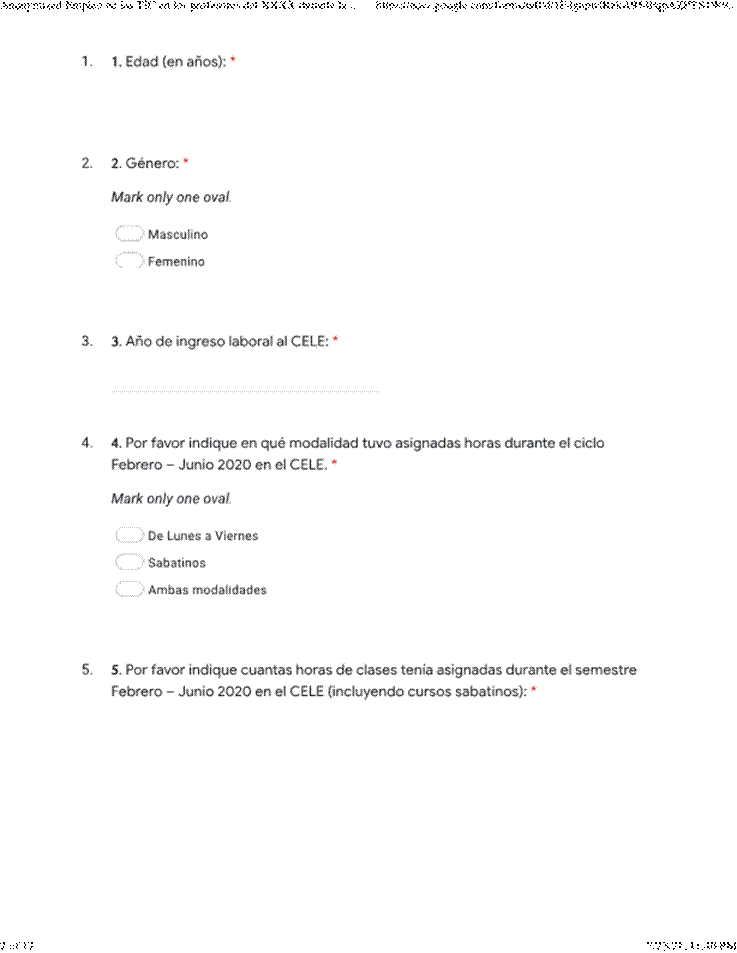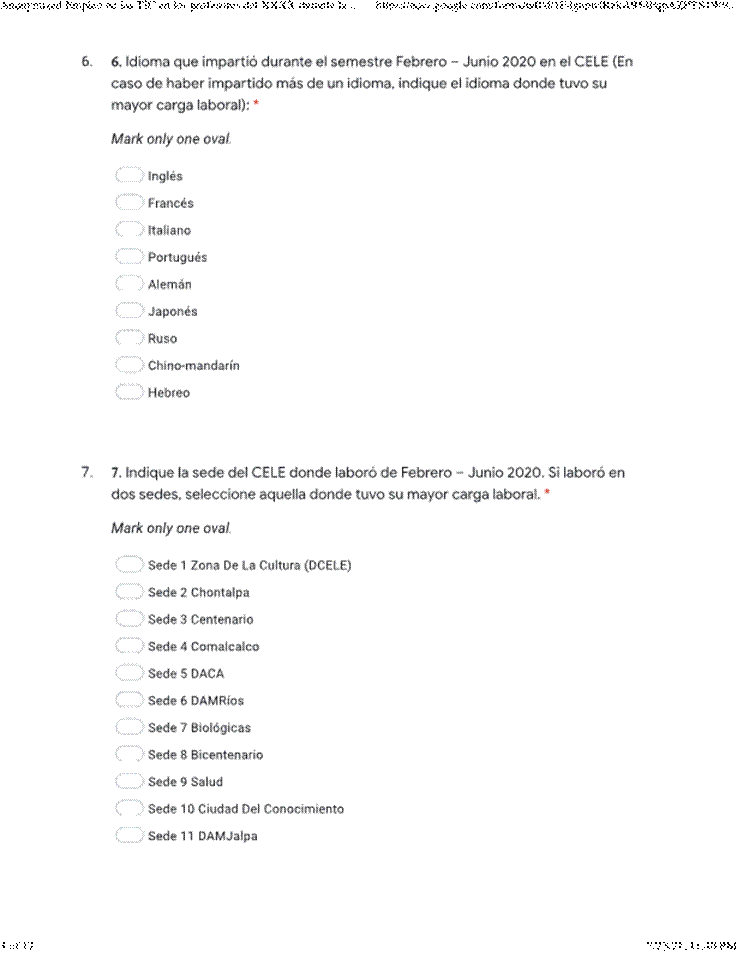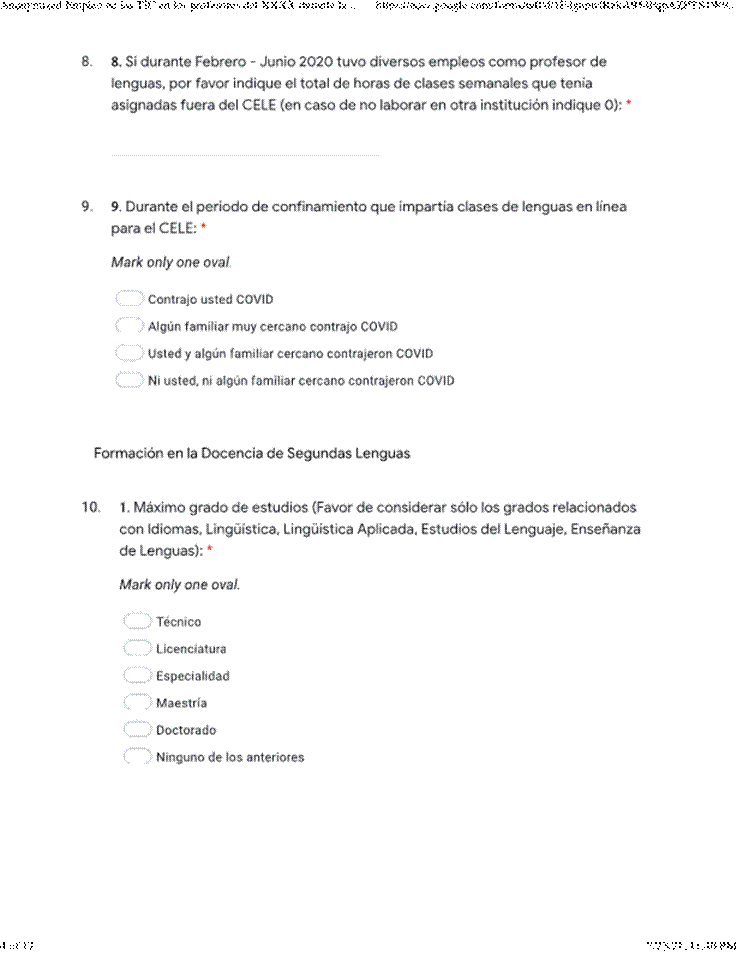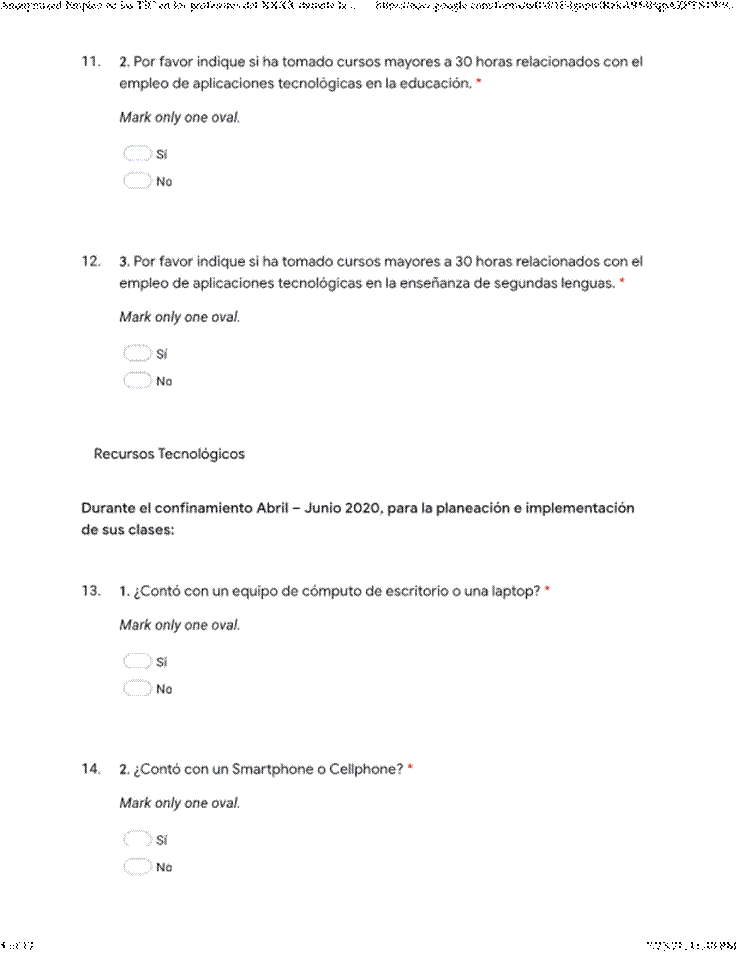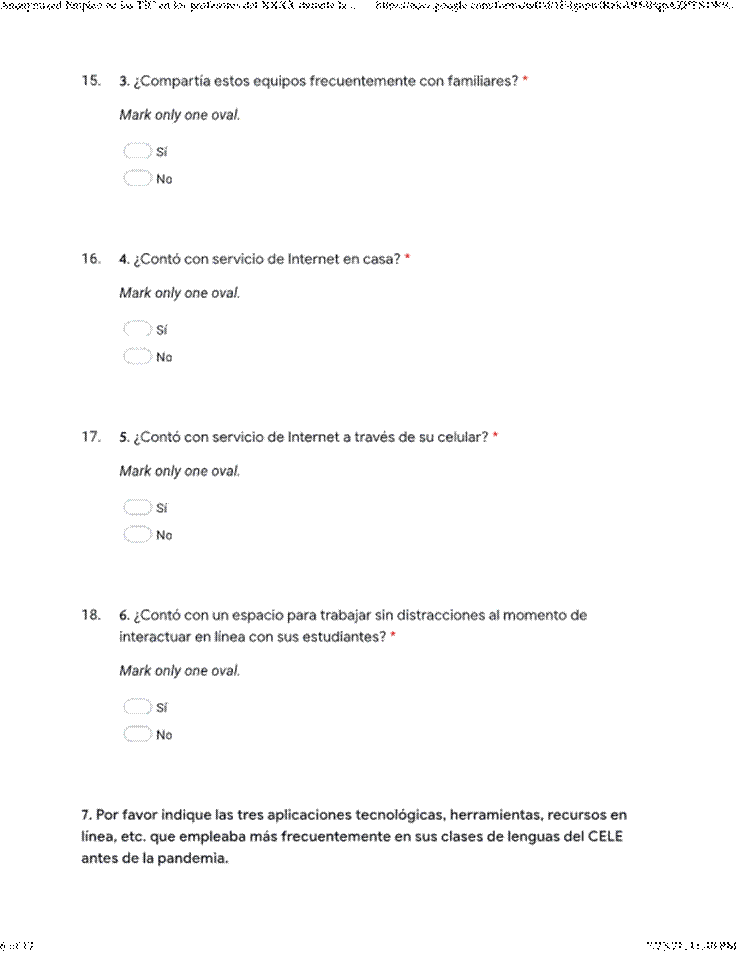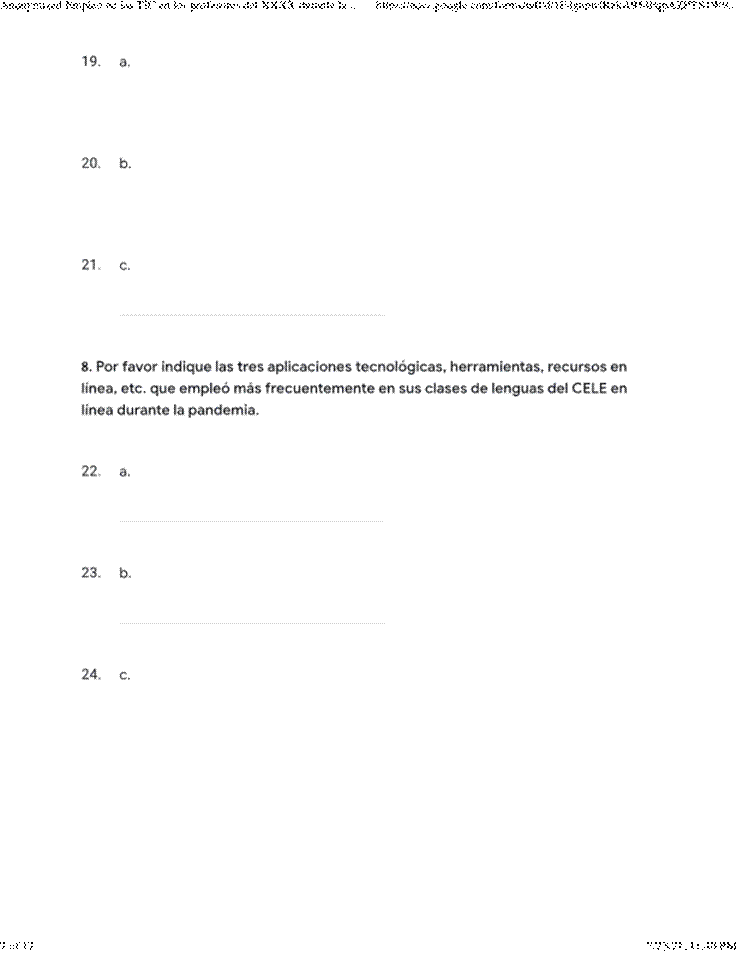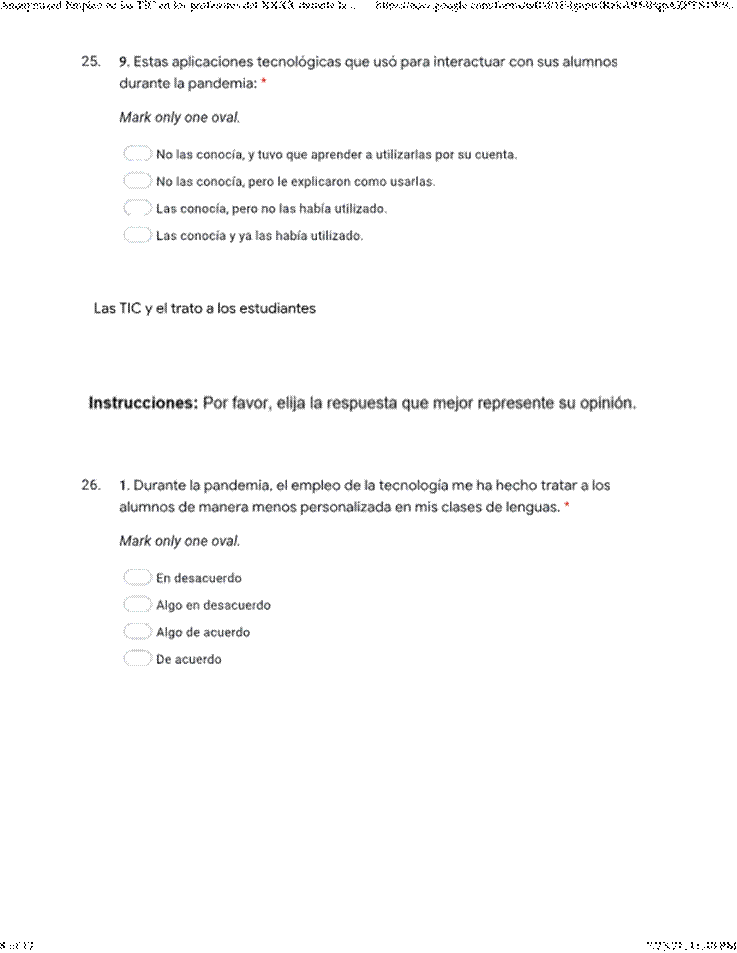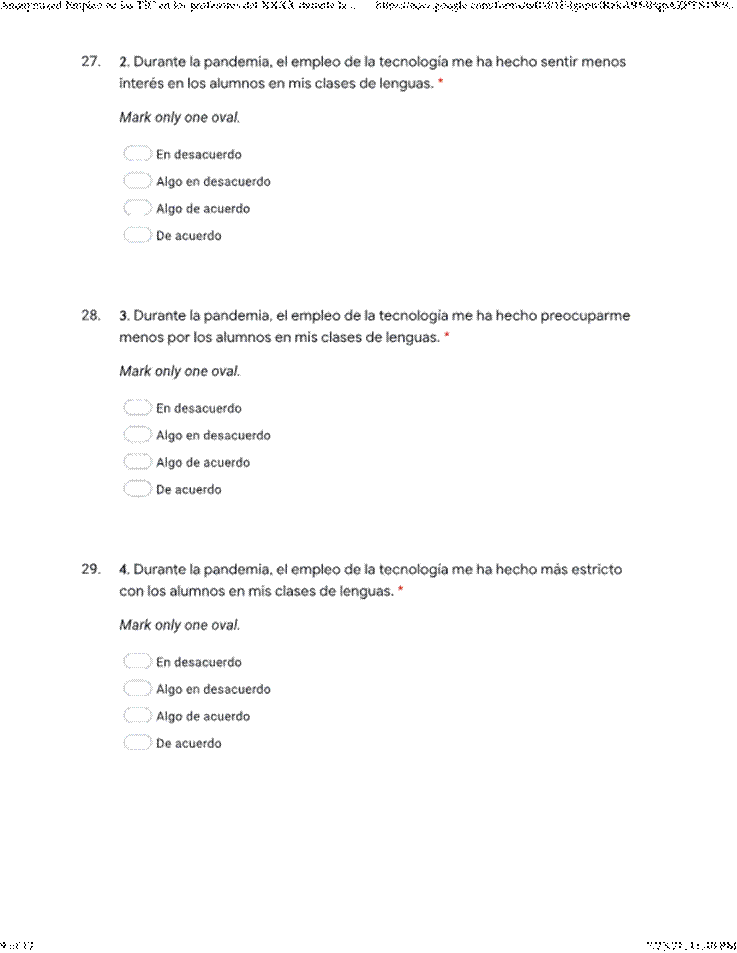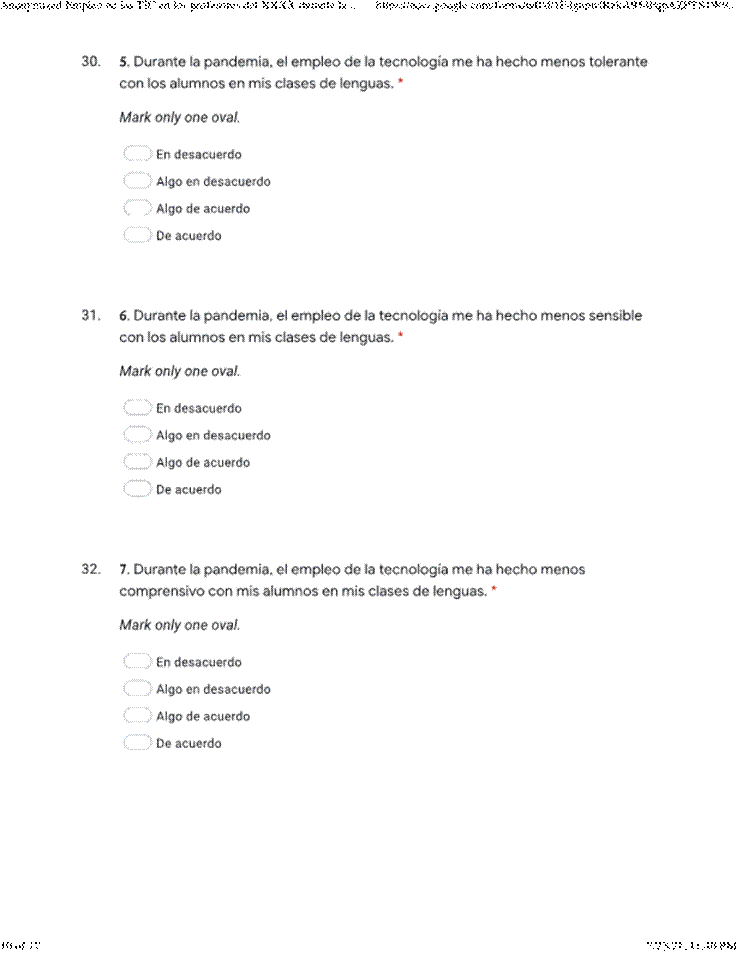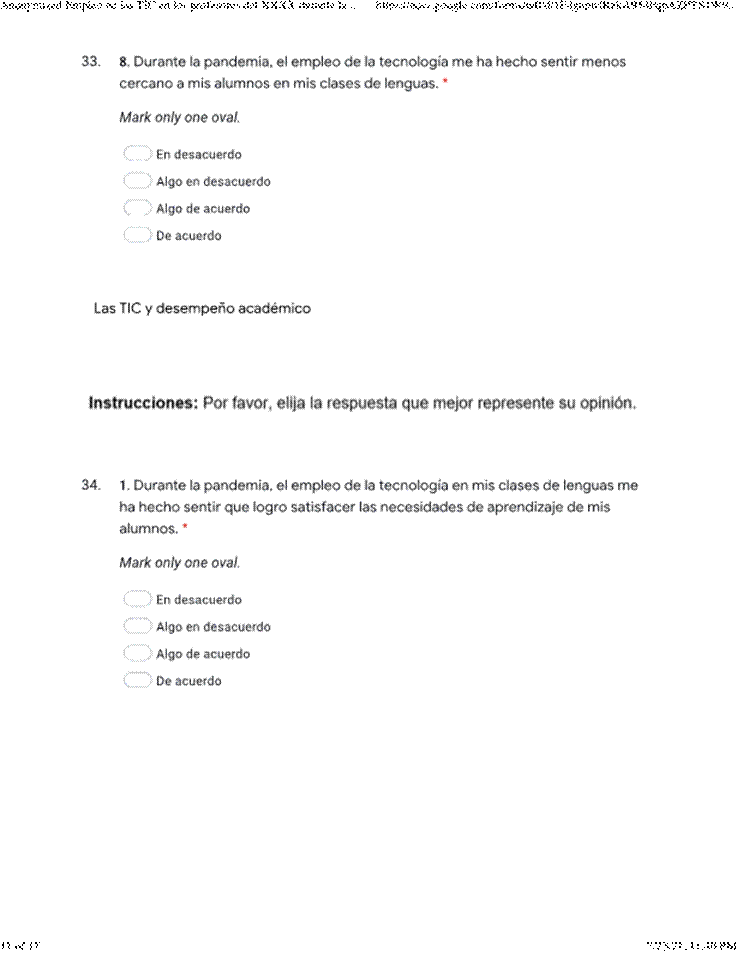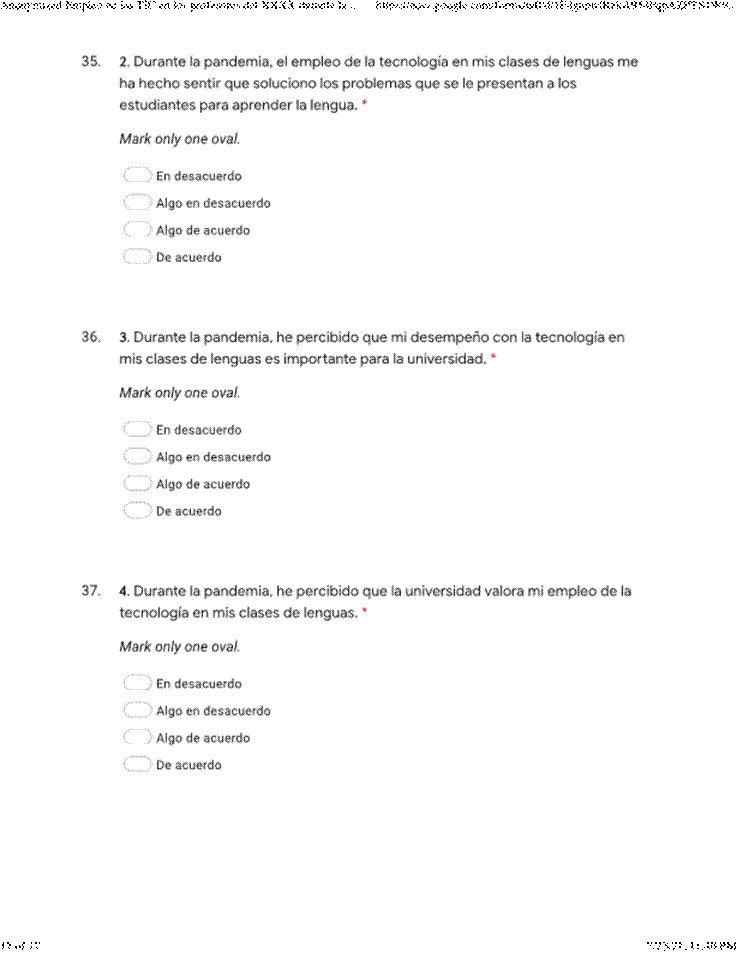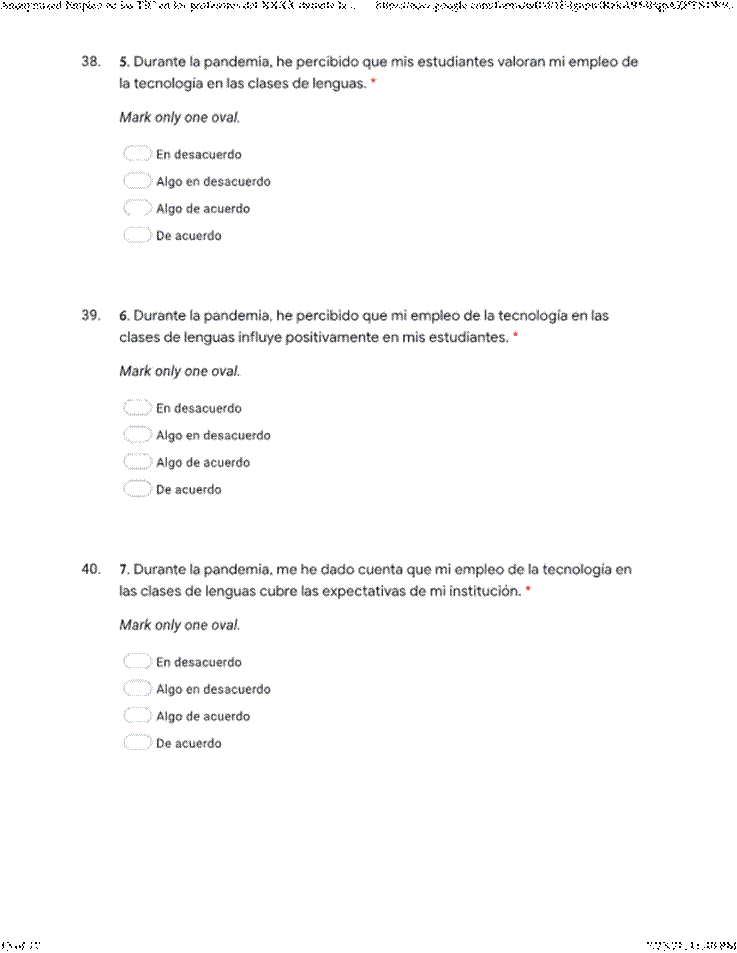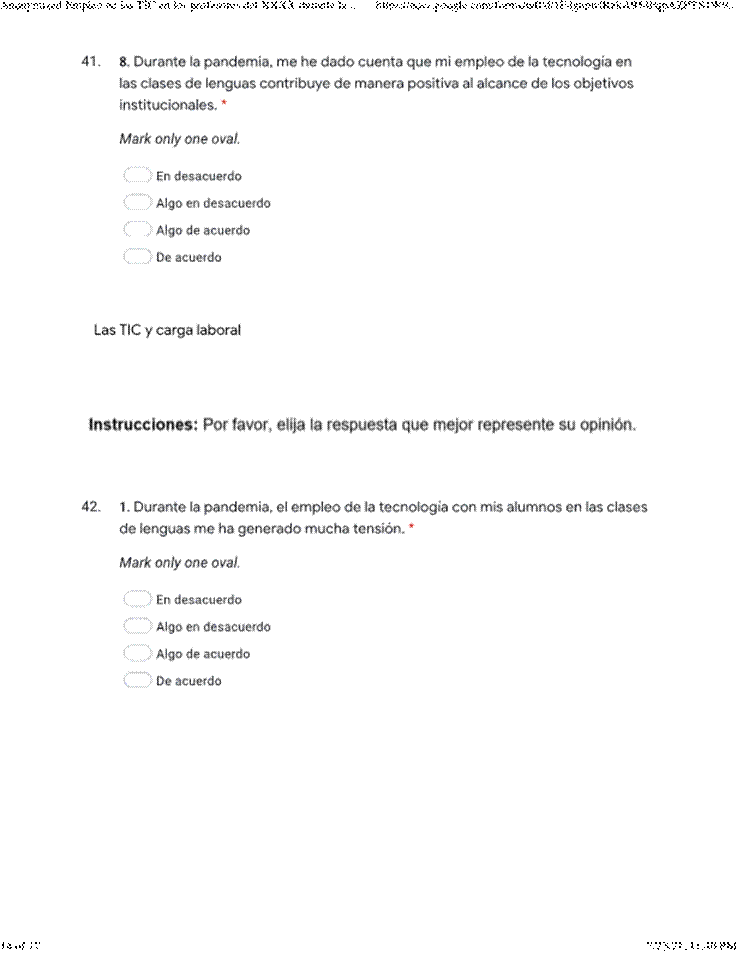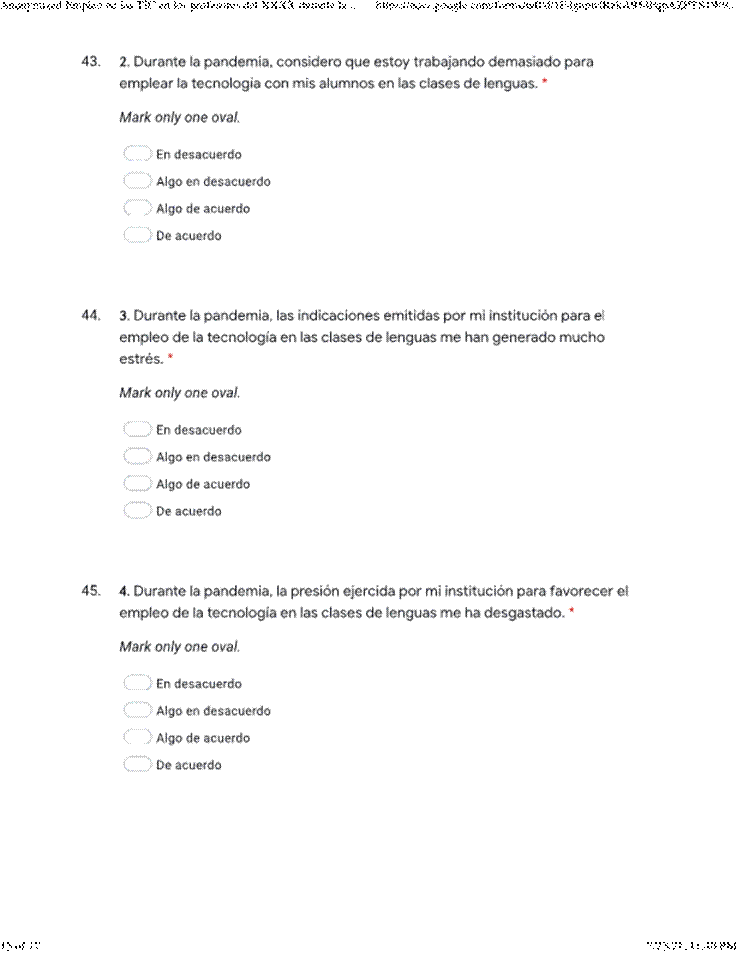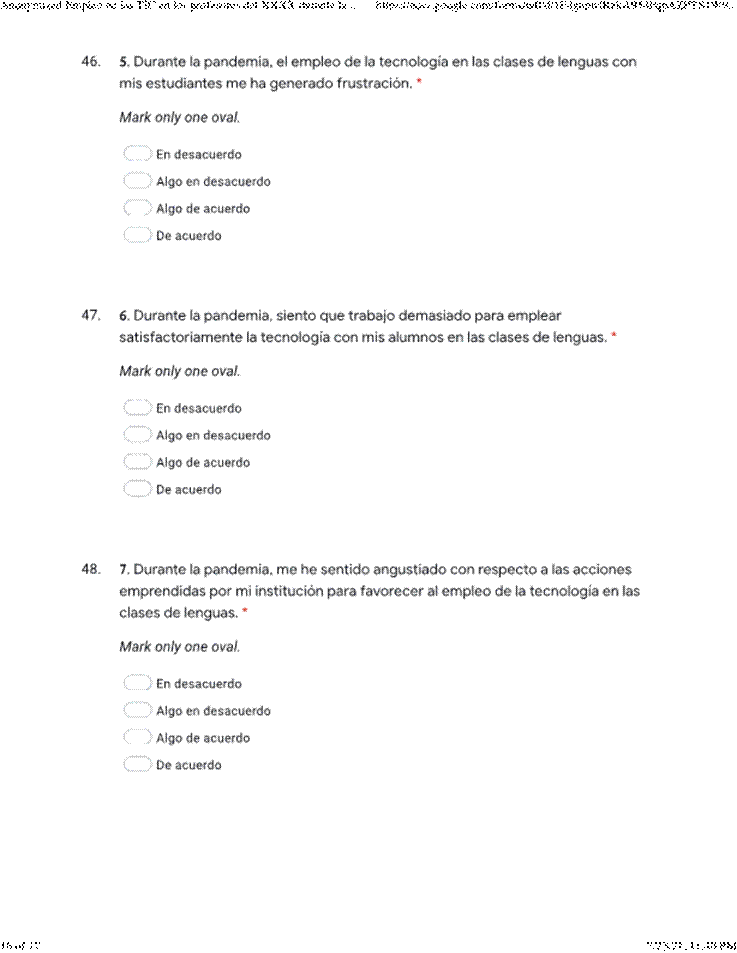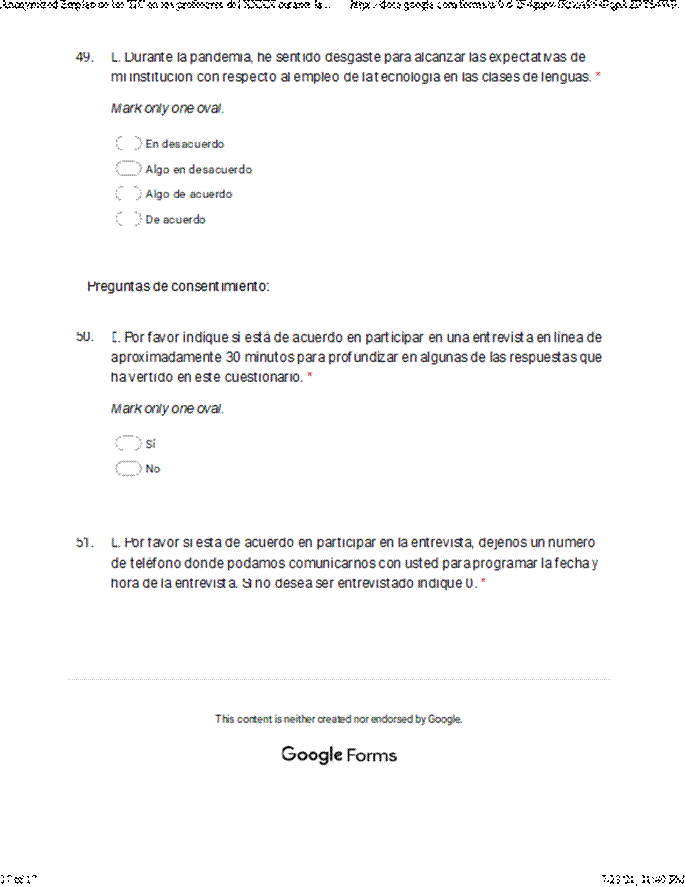Introduction
Prior to the world COVID-19 pandemic, researchers and educators had extensively debated on the feasibility, strengths and shortcomings behind the integration of technology in various second/foreign language1 education contexts (e.g., classroom-based, online and blended). Research conducted with stakeholders, policy makers, teachers and learners provided evidence of mixed reactions that spanned from interest and enthusiasm, to anxiety and rejection. In light of these results, researchers and educators often agreed that educational systems need to foster proper teacher preparedness should they want to reduce the number of caveats behind the implementation of technology in language education (Dooly & Sadler, 2020; Lord & Lomicka, 2011). In addition to sustained access to and use of technology (Hedayati & Marandi, 2014), teacher preparedness should include educational policies and curricular guidelines, well-planned logistics and infrastructure, technology-enhanced language teacher education, and hands-on experience in the use of technology for language instruction (Bedoya et al., 2018; Lozano & Izquierdo, 2019).
However, vis-à-vis the fast spread of the COVID-19 pandemic in early 2020, educational organizations had little time to scaffold teacher preparedness, as governments urgently opted for the implementation of human isolation and physical distancing measures. These measures aimed to safeguard the health and well-being of citizens, but they came along with educational, social, and financial downturns. In terms of education, worldwide, the measures abruptly pushed more than a billion learners away from inperson classroom instruction across all layers and areas of education (Escudero, 2021). In Mexico, in more than 6,000 higher-education institutions, approximately four million students and 400,000 professors were pulled out from in-person instruction during the spring of 2020 (Escudero, 2021).
Instead, for the accomplishment of curricular goals, educators and learners migrated to off-campus educational conditions, where they needed to rely on the use of technology as the means of instruction in compliance with health protocols.
Recent research in the general field of education indicates that the conditions under which this migration occurred led teachers, parents, and learners to experience negative psychological reactions (Escudero, 2021). In language education, the various types of psychological reactions that teachers experienced during the abrupt migration to offcampus technology-mediated education require research attention (MacIntyre et al., 2020). It should be noted that prior to the pandemic, only some studies had explored the psychological well-being of teachers in language classrooms (e.g., Nagamine, 2018; M. Rezvani & S. Rezvani, 2017; Sadeghi & Khezrlou, 2016). Upon consideration of Maslach and Leiter’s (2008) construct of burnout, a handful of studies had examined language teacher’ exhaustion, depersonalization and reduced accomplishment. In these studies, it was observed that overwhelming teaching conditions led to high levels of burnout, which in turn work to the detriment of language education among teachers and learners (Meidani et al., 2019; Sadeghi & Khezrlou, 2016).
Due to the aforementioned issues, this study examined teacher burnout during the abrupt migration of language educators to off-campus technology-mediated instruction during the COVID-19 pandemic. Moreover, it explored the teacher preparedness conditions that characterized such migration towards technology.
Theoretical Framework
The following sections review theoretical and empirical research on the two central concepts that set the bases for the current study: teacher preparedness for the integration of technology in language education and language teacher burnout.
Teacher Preparedness and the Integration of Technology in Language Education
Extensive research has explored the manner in which the use of technology can be optimized for the enhancement of language teaching and learning across different educational modalities (for reviews, see Chapelle, 2001; Felix, 2004; J. Gillespie, 2020). In language teaching, as in other areas of education (e.g., Carrillo & Flores, 2020), there is a need of consensus on the nomenclatures that can be used for the categorization of the technology-enhanced educational modalities. Nonetheless, they can be classified as classroom-based, blended and online/ distance, depending on the reliance of language education on technology use and classroom-based interaction.
In classroom-based learning, technology serves to scaffold in-person language teaching and learning. In this modality, inside of the classroom, teachers may have access to technologies either systematically or sporadically throughout the lesson (Izquierdo et al., 2017). In blended learning, teachers implement language tasks that need to be carried out through different phases (Sagarra & Zapata, 2008). In this modality, for instance, teachers focus on the initial stages of the tasks in the classroom. Then, they ask the learners to complete the remaining stages of the task outside of the classroom through the use of technology. Different from classroom-based and blended teaching, distance language education takes place entirely outside of a classroom, usually through a learning platform or environment (Manegre & Kashif, 2020). In this modality, all learning goals, instructional tasks, and materials are conceived upon the principle that the course is delivered remotely with the aid of technology. Also, different from the other two modalities, in distance education, the integration and selection of technological resources adhere to institutional regulations, curricular aims, a student learning approach, and outcome evaluation principles.
Across these contexts, the number of resources for the enhancement of language learning have increased with the fast development of technology, as computer-assisted language learning (CALL) research reveals (see Golonka et al., 2014; Bedoya et al., 2018; J. Gillespie, 2020). The available resources span from technologically intricate environments, such as virtual reality, online games, and virtual classrooms to less technologically demanding resources such as video communication, mobile texting, and emails. While the wide array of technologies continues to increase, teachers and learners do not necessarily share the same viewpoint about the use of technology in language education. Learners, on the one hand, often value technology-enhanced education as long as the integration of technology in the language lessons and tasks comes with proper teacher guidance and support (Bedoya et al., 2018; Felix, 2004; Harker & Koutsantoni, 2005). Teachers, on the other hand, often display reactions that may range from enthusiasm to rejection (Chambers & Bax, 2006; Hedayati & Marandi, 2014; Manegre & Kashif, 2020).
Negative feelings and attitudes among language educators can be associated to lack of preparedness for the proper use of technology (Dooly & Sadler, 2020; Lord & Lomicka, 2011; Yoon & Gruba, 2019). Language teacher preparedness involves different readiness conditions. In this regard, teachers would first argue that the institutional conditions play a key role in their decision whether technology could be implemented in their lessons. Often, teachers emphasize that educational stakeholders need to consider the provision of proper physical, technological, and curricular infrastructure, in addition to support and logistics (Chambers & Bax, 2006; Izquierdo et al., 2017). Once these aspects have been taken care of, teachers would advocate for another condition: access to technology. This involves not only the availability of technological resources such as connectivity, hardware and software at school and at home. It also encompasses the institutional and personal allocation of time for the preparation, implementation, and follow-up of the technology-enhanced lessons (Chambers & Bax, 2006; Hedayati & Marandi, 2014).
Proper institutional conditions and technology access are valuable conditions of teacher preparedness. Nonetheless, language teachers may yet struggle with the actual use of technology when they lack techno-pedagogical competencies (Bedoya et al., 2018; Yoon & Gruba, 2019). These competencies involve knowledge, skills, and attitudes for the identification, selection, adaptation, implementation, and evaluation of technological resources that can help teachers create the necessary conditions for language acquisition (Bedoya et al., 2018; Chapelle, 2001; Lord & Lomicka, 2011). These conditions encompass ample opportunities for language exposure, production and form-meaning mapping in the language tasks that teachers implement by means of technology (Izquierdo, 2014). The development of these competencies is a complex process, but it can be effectively scaffolded through CALL teacher education where teachers gain technological knowledge, knowledge of the process of language acquisition, hands-on training on the design, and implementation of technology-based language tasks, as well as reflective skills and peer collaboration experience (Bedoya et al., 2018; Lozano & Izquierdo, 2019).
This section addressed the relevance of various teacher preparedness conditions for the integration of technology in language education. To this end, it provided insights into the institutional conditions of teachers (Izquierdo et al., 2017; Chambers & Bax, 2006), technology access and use (Hedayati & Mirandi, 2014; Maegre & Kashif, 2020) and CALL teacher education (Bedoya et al., 2018; Dooly & Sadler, 2020) which deserve consideration for the implementation of technology-enhanced education under regular instructional circumstances. To further explore these conditions, empirical data are needed when the implementation of technology in language education is not a matter of choice. Since the teacher preparedness conditions that circumscribe the use of technology may lead teachers to experience various types of psychological reactions. The following section discusses the importance of the study of teacher burnout when technology is implemented under unconventional language educational circumstances.
Teacher Burnout in Language Education
Reference to the construct of burnout can be traced back to the 1960s in the healthcare system. Early explorations of burnout were conducted with nurses and physicians to identify the deterioration of their psychological well-being in their work environment (Freudenberger, 1974; Rotenstein et al., 2018). Results often pointed to exhaustion, depersonalization and absence of work commitment (Maslach et al., 2001). These findings led Maslach et al. (1997) to conceptualize these negative reactions as the dimensions of the burnout syndrome, which results from the interaction of service providers with individuals in the workplace. The first dimension, exhaustion, constitutes a response to working conditions that lead to chronic physical and emotional fatigue. The second dimension, depersonalization, relates to the absence of concern for people in the work environment. The last dimension, reduced accomplishment, is circumscribed to low self-realization and productivity at work.
The concept of burnout was later extrapolated beyond the healthcare system to institutional and organizational contexts where other service types are provided and which require contact with people (Meidani et al., 2019). In educational institutions, burnout and its three dimensions are explored through the Maslach Burnout Inventory (Maslach et al., 1997), or minor adaptations of this inventory. In language education, this inventory has been administered in various education contexts which include elementary schools (Mukundan et al., 2015), secondary schools (Sadeghi & Khezrlou, 2016), high schools (Heidari & Gorjian, 2017), private language institutes (Meidani et al., 2019) and higher education (M. Rezvani & S. Rezvani, 2017). As in other areas of education, results indicate that teachers experience substantial levels of burnout which work not only to the detriment of their well-being, but also to the detriment of their professional interest and teaching performance (Meidani et al., 2019). They also negatively affect the well-being of the learners, as learners become sensitive to teacher burnout and experience negative reactions such as stress and anxiety (M. Rezvani & S. Rezvani, 2017), low achievement, and learner-teacher rapport deterioration (Heidari & Gorjian, 2017).
As for the manifestation of burnout itself, research reveals that language teachers do not necessarily report similar effects across the exhaustion, depersonalization and reduced accomplishment dimensions. For instance, some teachers experience exhaustion and depersonalization, but may maintain commitment with academic achievement in their classrooms (M. Rezvani & S. Rezvani, 2017). Other studies reveal that, as teacher exhaustion increases, teacher empathy with the learners and teacher accomplishment decrease (Heidari & Gorjian, 2017). Furthermore, teacher burnout is sensitive to specific aspects of the teaching context such as the workplace, infrastructure, work overload, high job demands, and institutional expectations (Meidani et al., 2019; Sadeghi & Khezrlou, 2016). Language teachers in higher education, for instance, experience less burnout than teachers in secondary schools. Likewise, the amount of workload is another aspect of the teachers’ context which is closely tight to emotional exhaustion. Other aspects of the context that contribute to teacher burnout are poor student performance or misbehavior. These learner characteristics have a negative impact on teacher interest in the lessons and contribute to depersonalization and low academic achievement.
Particular aspects of the profiles of the language teachers themselves have been identified as teacher burnout predictors. In this regard, teachers’ viewpoints of their own experiences influence their level of burnout (Meidani et al., 2019). Teachers with positive perspectives of their past experiences are less likely to experience burnout, and thus, more likely to display high achievement levels. Nonetheless, teachers with fatalistic views of their present conditions are prone to experiencing higher levels of burnout. Another teacher characteristic which can predict burnout is the number of years in the teaching profession (Mousavy et al., 2012). While teachers may display similar levels of depersonalization and accomplishment irrespective of their number of teaching years, they tend to experience more exhaustion as the number of years in the teaching profession increases. The educators’ ability to reflect upon their teaching practice constitutes another important teacher characteristic that may predict burnout effects (Shirazizadeh & Karimpour, 2019). Reflective teachers, for example, are less susceptible to burnout, as their reflection ability heightens their teaching confidence and efficacy.
In sum, teacher burnout is a complex psychological reaction which has received research attention in regular language classrooms. In these educational settings, research points to contextual and personal conditions that promote teacher burnout; furthermore, the empirical evidence substantiates that some conditions may affect some burnout dimensions more than others. Due to the ongoing situation of the worldwide COVID-19 pandemic, which pushed teachers to halt in-person instruction overnight, questions arise with respect to teacher burnout and other psychological reactions in the context of technology-mediated education (Carrillo & Flores, 2020; Escudero, 2021). In language education, recently published research reveals that teachers from various international contexts have experienced high levels of negative psychological reactions, such as stress and anxiety during off-campus instruction delivery. These and other psychological reactions deserve research attention, as they interfere with the language educators’ ability to teach and promote disengagement, denial and distraction (MacIntyre et al., 2020).
Method
To achieve the study aim, a quantitative descriptive design was used. This design enables the collection of numerical data without an alteration of the natural conditions of the study participants (Cohen et al., 2007; Field, 2013). Subsequently, in this study, numerical data was collected about teacher preparedness and teacher burnout conditions during technology-mediated language instruction. Based on the research design, the data was analyzed for a description of the conditions of interest. The following sections describe the participant selection, instrument organization, data collection, and analysis procedures of the research.
Context and Participants
In Mexico, the national and state governments called for a halt to non-essential activities in the spring of 2020; by the end of April 2020, all 32 Mexican states had ceased in-person education. Facing the rapid spread of the virus in the state of Tabasco (see Figure 1), the state authorities suspended all types of activities across the levels of education for three weeks around Easter break.

Source: https://www.arcgis.com/apps/opsdashboard/index.html#/c7776ae836434ffb9659e9cfdda71b22
Figure 1 Spread of COVID-19 in the Mexican State of Tabasco
After this time, the state authorities asked teachers to resume their teaching duties from home. To this end, the public university where this study was conducted, granted all teachers access to Microsoft Teams for the delivery of instruction. Nonetheless, the use of this platform remained optional and teachers were allowed to implement the technological resources that best suited their teaching needs. All university instructors were required to submit their lessons and lectures weekly, but the principles behind the integration and selection of technological resources, the learning-teaching approach and outcome evaluation remained institutionally undefined.
At the start of the pandemic, the university’s language center counted with approximately 150 instructors; they taught Chinese, English, French, German, Hebrew, Italian, Portuguese, and Russian to more than 12,000 students in a total of 577 groups. They attended 495 groups in the weekday option and 82 groups in the intensive Saturday program. During regular in-person teaching conditions, instructors in the weekday program would daily teach each group a one-hour lesson from Monday through Friday, whereas teachers in the intensive program would work with their group for four hours every Saturday. The teachers deliver their lessons on the main campus of the university or on one of the university language center’s seven campuses which are located in various geographical areas of the state. With the in-person teaching prohibition, the entire teacher population had to migrate to off-campus technology-mediated instruction under the technological circumstances previously mentioned.
In order to carry out the study, the research team contacted the language center dean and vice-dean for academic affairs and informed them of the study purpose, data collection instruments and ethical procedures. Upon approval from the dean’s office, the vice-dean for academic affairs contacted all the teachers via the instant messaging service WhatsApp. For compliance with ethical regulations, in the text message, the teachers were informed that participation was voluntary. Teachers who were interested in the study accessed the data collection instruments through a link to Google Forms. On the welcome page of the Google Forms site, they were informed of the study purpose and ethical regulations. They were also provided with an email address should they later wish their data to be removed from the study.
A total of 104 teachers of English (85%), French (7%) and other languages (8%) were included in this study. They all consented to participate in the study and electronically completed the data collection instruments. This sample provides a high level of representativeness, as it constitutes approximately 70% of the entire language center teacher population. From the total number of participants, 53% of them were female teachers. While the age of the teachers ranged from 25 to 59 years old, 80% of the respondents were within the 30 40 years-old range. Approximately 50% of the teachers were affiliated with the main campus of the language center, whereas the other half of the teachers were affiliated with one of the other campuses across the state of Tabasco. The largest number of teachers (50%) taught weekday courses only, whereas the others would teach in the intensive program (25%) or in both modalities (25%). In terms of their health conditions during the transition to off-campus technology-mediated language instruction, 20% of the participants indicated that they or a family member with whom they lived had contracted COVID-19. Further details on their institutional conditions are provided in the teacher preparedness result section.
Data Collection
The data were collected via Google Forms (see Appendix). After the welcome page, participants were presented with the teacher preparedness survey and teacher burnout questions in Spanish.
Teacher Preparedness Survey
Based on the consideration that surveys constitute a valuable instrument for the collection of factual information in education (Cohen et al., 2007), this instrument was selected for the exploration of the teacher preparedness conditions for technology-mediated language instruction and the teacher socio-demographics. In terms of teacher preparedness, the institutional conditions, teacher education and technology access/use were explored. These areas of exploration emerged from the theoretical and empirical research that was reviewed in the sections above (e.g., Chambers & Bax, 2006; Dooly & Sadler, 2020; Hedayati & Marandi, 2014; Lord & Lomicka, 2011).
The survey questions, in the Appendix section, included 21 prompts which were presented in the form of close-ended (n = 19) and open-ended (n = 2) questions; the questions were distributed across three sections. Section 1 included nine questions about the socio-demographics of the participants, their on-going COVID-19 situation and one aspect of teacher preparedness (i.e., their institutional condition). Section 2 included three questions that explored other aspects of teacher preparedness: language teacher training, educational technology knowledge and CALL teacher education. Section 3 investigated teacher preparedness in terms of technology access and use during language teaching. In this section, six close-ended questions elicited information about teacher access to connectivity, hardware, and software at home.
Through two open-ended questions, this section also inquired about the technological resources that teachers relied upon for the development of their lessons prior to and during the pandemic. Additionally, a teacher education question was included in this section and asked for the manner in which teachers had gained experience with the resources they were using in the technology-mediated lessons.
Burnout Questionnaire
For the exploration of teacher burnout, the Maslach Burnout Inventory (Maslasch et al., 1997) was considered. Adapted versions of this instrument have been used in previous language investigations and have yielded high reliability coefficients (e.g., Meidani et al., 2019; Mukundan et al., 2015; Nagamine et., 2018; Sadeghi & Khezrlou, 2016; Shirazizadeh & Karimpour, 2019). In these studies, the three dimensions of teacher burnout have been examined. Within the dimensions, researchers have modified some elements of the sentences for each item or for items excluded for compliance with ecological validity during the study realization.
In the current study, the three dimensions of the burnout questionnaire were retained as well: exhaustion, depersonalization, and accomplishment (Maslasch et al., 1997). The burnout questions that our participants completed included similar numbers of items (n = 8) in each dimension, and thus, the total number of items added up to 24 (see questions 26-49 in the Appendix). Modifications were made in the items’ sentences for their contextualization within technology-mediated language instruction. For instance, Depersonalization Item 2 stated, “In my technology-mediated language lessons, I feel less interest in my students.” Within each dimension, all the items were verified for adherence to semantic direction (Field, 2013; Hodge & D. Gillespie, 2007). Upon this consideration, the items held a negative semantic load for exhaustion (I work too much, I feel more stressed-out, I experience frustration) and depersonalization (e.g., I feel less interest, less tolerance, less sensitive, etc.). Nonetheless, within the accomplishment dimension, the items carried a positive semantic load (e.g., I feel satisfied, the university values my use of technology, etc.).
In the original questionnaire, the level of participant burnout is documented through a series of items with a Likert-scale in which the participants express their level of agreement with the situation in the items (Maslach et al., 1997). In the versions of the questionnaire which have been used with language educators, the number of agreement levels has varied, with some authors including a neutral point. In our version of the questionnaire, the participants were presented with a four-value scale where they could select: I disagree, I partially disagree, I partially agree, or I agree. The use of a four-value scale favored the elicitation of a more concise participant viewpoint in comparison to scales that include a larger number of values (Field, 2013; Hodge & D. Gillespie, 2007). Moreover, the exclusion of a neutral point forced the participants to take either a positive or negative position while allowing them to express this position through two magnitude levels (e.g., I disagree or I partially disagree). For the reliability analyses, the answer choice accounted for 1 (disagree), 2 (partially disagree), 3 (partially agree), or 4 (agree) points.
Instrument Validity and Reliability Analyses
The initial versions of the survey and of the burnout questionnaire prompts were prepared by the first author. Then, the co-authors and a sample of teachers from the language center acted as judges who analyzed both instruments for construct and ecological validity. As for construct validity, the judges analyzed the congruence between each section or dimension and its questions (Cohen et al., 2007). As for ecological validity, the judges examined the pertinence of the survey and questionnaire prompts considering the study participants and their context (Cohen et al., 2007). After this process, five questions were added to the initial version of the survey; additionally, the semantic direction of some items from the exhaustion (n = 3), depersonalization (n = 4), and accomplishment (n = 3) dimensions of the questionnaire was revised, as well as their adherence to the principles of univocity and unidimensionality (Field, 2013; Hodge & D. Gillespie, 2007). The final version of the burnout questionnaire prompts were further subject to reliability analyses, which yielded favorable Cronbach alpha coefficients (see Field, 2013) for the three dimensions: exhaustion (.90), depersonalization (0.72), and accomplishment (.87).
Data Analysis Procedures
Google Forms automatically generated an Excel spreadsheet with the survey and questionnaire answers. A research assistant checked the Excel document to identify missing data or confusing answers. The research assistant and the first author also analyzed the answers to the two open-ended survey questions to identify the technological resources reported by the teacher. Using the statistical software, SPSS version 25, frequency analyses were run on the answers to the close-ended questions of the survey (Field, 2013) and the resources reported through the two open-ended questions. As for the burnout questionnaire, independent Cronbach analyses were run with each dimension to identify reliability coefficients (Field, 2013). Then, for each item, frequency distribution analyses of the participants’ answers were performed across the Likert-scale values.
Results
In the following sections, the results for the various aspects of teacher preparedness are first presented. Then, the results of the burnout questionnaire are provided for each dimension.
Teacher Preparedness
The upcoming sections present the frequency analysis results for the three teacher preparedness conditions that were explored in the survey.
Institutional Conditions
In this survey section, the data revealed that the majority of the teachers had taught at the language center for fewer than 10 years. Specifically, Figure 2 illustrates that half of the participants had been in the language center between six and 10 years (n = 52) and that the most recently hired instructors constituted the second largest group (n = 22). The most experienced group of teachers (between 20 and 30 teaching years) accounted for 6% of the population. In terms of age, the survey data indicated that the most senior teachers (50 60 years old) were the smallest age group (n = 3), followed by the youngest group of instructors (n = 9; 25-30 years old). The age of the largest group of teachers ranged between 31 and 40 years old (n= 65), followed by the 41 50 years-old teacher group (n = 27).
As for the weekly workload, at the time of the study, the vast majority of the teachers worked at the language center only (62%), whereas other teachers held additional teaching appointments in other institutions. Figure 3 reveals that, approximately, half of the participants (n = 53) taught between 20 and 30 hours per week at the language center. Outside of the language center, about 25% of the teachers would work for more than 16 hours per week.
Teacher Education Conditions
With regard to language teacher education and training, the majority of the participants had earned an undergraduate degree only (n = 60). Other participants held either an advanced diploma (n = 2) or an MA (n = 41) that was related to language pedagogy. None of these studies included training on educational technology or CALL. However, some teachers had independently attended seminars or workshops in educational technology (n = 48), and fewer participants had undertaken some kind of professional development that focused on CALL (n = 28).
Technology Access/Use Conditions
In terms of the technology access conditions that characterized off-campus technology-mediated language instruction, Figure 4 shows that access to hardware, home Internet and mobile Internet for the delivery of the lessons from home was not a limitation. Moreover, approximately 70% of the informants had a designated workspace at home and did not share their equipment with family members.
As for technology use, the two open-ended questions inquired about the technological resources that the language teachers would use for teaching before and during the pandemic. The resources were identified as technologies for lesson support or for teacher-learner interaction. Figure 5 shows that, in the former category, some participants (n = 32) reported using Google Drive®, Google® search, Kahoot®, language websites, MS PowerPoint® files, videos, or YouTube® videos prior to the pandemic. Nonetheless, during the pandemic, the teachers infrequently relied on their use.
Figure 6 displays the resources that the majority of teachers (n = 93) used for interaction with their learners during the pandemic. Among these resources, Google Classroom®, WhatsApp®, Zoom®, and Microsoft Teams® were the most popular choices. Prior to the pandemic, with the exception of WhatsApp®, teachers did not much favor their use. In the survey, one-third of the participants reported that they had used these resources during in-person language instruction. However, the vast majority (64%) of the informants had not used them before the pandemic and, had to autonomously learn about them and figure out their use. Only a small number of teachers (3%) received assistance from peers, relatives, or friends for the implementation of these resources.
Teacher Burnout
Figures 7 through 9 display the distribution of the participants’ answers across the Likert-scale values for the items in each dimension. In the upcoming descriptions, the number of participants who reported agreement and partial agreement were added. Likewise, the participants who indicated disagreement and partial disagreement were pooled.
Exhaustion
For this dimension, Figure 7 shows that, from the eight items, three of them elicited negative reactions amongst the participants. Specifically, the majority of participants agreed that they felt the pressure to integrate technology in their lessons (67%), experienced work overload for the integration of technology in language instruction (71%), and felt worried about the proper use of the technology they were relying on (58%). Nonetheless, in the items that explored the effects of institutional demands, many participants expressed disagreement with the idea that institutional demands had led them to experience stress (60%), exhaustion (75%, 70%) or anguish (70%).
Depersonalization
Figure 8 shows that, from the eight depersonalization items, five of them elicited high levels of disagreement. A large number of participants rejected the idea that they felt less interest (87%), concern (93%), tolerance (94%), susceptibility (97%) and understanding (98%) towards their learners during technology-mediated language instruction. In comparison to these numbers, the lack of personalization (57%), flexibility (66%) and closeness (58%) during the language lessons elicited less rejection.
Accomplishment
The items in this dimension systematically elicited agreement in terms of accomplishment. In this respect, Figure 9 illustrates that the participants felt that they paid attention to learner needs (74%) and provided solutions to their problems during technology-mediated instruction (76%). Moreover, they felt that their teaching performance with the use of technology helped them gain learner appreciation (85%) and positively influenced the performance of the learners themselves (93%). At the institutional level, the respondents felt they had complied with guidelines (94%), met expectations (88%) and goals (95%), and gained appreciation (88%).
Discussion and Conclusion
This section first summarizes the participants’ teacher preparedness and burnout conditions around the use of technology for off-campus language instruction delivery during the COVID-19 pandemic. Then, the potential interface between these conditions is discussed.
In terms of teacher preparedness for technology-mediated instruction delivery, the participants faced institutional challenges related to a heavy workload in their teaching context. As for technology, they held sustained access to hardware and Internet. However, they lacked teacher training, or knowledge and experience on the use of software and applications for language education. Thereafter, they autonomously worked on the identification of technological resources for the delivery of their lessons’ content and figured out their use. With regard to burnout, the participants experienced exhaustion during the delivery of technology-mediated language instruction, pressure for the identification of technologies that could facilitate instruction delivery, and concerns about the proper use of the selected technologies. Institutional regulations did not lead the participants to experience exhaustion, however. The depersonalization data indicates that the participants rejected the idea that the use of technology had had a negative impact on teacher-learner rapport. As for accomplishment, the teachers felt their use of technology helped them accomplish their teaching duties and gain institutional and learner appreciation.
The teacher preparedness conditions for technology-mediated instruction in this study can partially explain some of the burnout effects that the teachers experienced during off-campus technology-mediated language instruction. The data analysis results made evident that the university instructors enjoyed a privileged technological status due to their sustained access to hardware and connectivity. This access to technology differs from the conditions of teachers in other sectors of Mexican public education who showed limited access to hardware and the Internet during the pandemic (Escudero, 2021). Moreover, it diverges from the limited access to technology and connectivity that language teachers had often reported in other levels of public education (Izquierdo et al., 2017). Their technology access is even remarkably different from the technology and Internet which are available to teachers for language instruction in Mexican rural schools (Izquierdo et al., 2021).
Nonetheless, despite favorable technology access, other aspects of teacher preparedness brought about major challenges for the integration of technology in off-campus language instruction at the start of the pandemic. The first challenge related to the participants’ institutional conditions. As in other international contexts (Chambers & Bax, 2006; Hedayati & Marandi, 2014), the participants faced the demand of technology use for language instruction with an overwhelming number of teaching hours in addition to the lack of time allocation for lesson preparation/follow-up and assignment marking. The second challenge emerged from the lack of technology-oriented teacher education (Dooly & Sadler, 2020; Lord & Lomicka, 2011). In the absence of educational technology or CALL teacher education, the teachers were in need of technological knowledge, pedagogical principles and expertise for the creation of optimal language acquisition conditions through the use of technology (Chapelle, 2001; Lozano & Izquierdo, 2019). These findings substantiate the argument that educators often lack the necessary teacher preparedness conditions for the enactment of institutional and curricular policies that demand innovation in public language education through the use of technology (Hedayati & Mirandi, 2014; Izquierdo et al., 2017).
Prior to the pandemic, some teachers were accustomed to technological resources for supporting in-person language instruction. For instance, they were at ease with resources such as pdf files, videos, PowerPoint presentations and websites. For inperson instruction, these resources are becoming normalized in public classrooms (Izquierdo et al., 2017, 2021). Teachers have been observed to rely on PowerPoint slides and videos for the provision of grammar and pronunciation rules, in addition to vocabulary. PDF files serve for the provision of grammar-oriented sentence completion activities. Their use is often regarded as an element of technological innovation in public language education although they merely constitute a replacement of traditional printed and audio-visual classroom materials, or input for structure-based instruction.
The change in technological resources that teachers faced during the pandemic points to the need of complex technological platforms and networks such as Microsoft Teams®, Google Classroom®, and Zoom®. These resources constitute valuable options for remote language instruction, as they embody several tools for class management, material repository, and teacher-learner interaction through written, oral, and video-based communication in a synchronous and an asynchronous fashion (Bedoya et al., 2018; Hsu, 2016; Peeters & Pretorious, 2020). Nonetheless, their functionality requires that users develop advanced technological knowledge and acquire a sound understanding of their pedagogical use (Hsu, 2016; Peeters & Pretorious, 2020).
Bedoya et al. (2018) indicate that these types of platforms serve various pedagogical purposes of which language teachers need awareness. One of them relates to the development of the class dynamics. That is, teachers may use platforms for the provision of reminders and information about assignments, the class pace and feedback on the class performance. Another function is information management. This allows teachers to use the platform as a material repository, from which learners could access material that scaffolds lesson content delivery. Finally, the platform can function as a communication means between teachers and learners, and among learners themselves. The communication function of platforms is highly valued in CALL (Hsu, 2016; Peeters & Pretorious, 2020), as during technology-mediated interaction, learners have opportunities for negotiation of meaning and attention to form with peers and teachers in the target language (Chapelle, 2001; Izquierdo, 2014).
Under these circumstances, the migration to technology-mediated instruction brought about major teaching challenges, and thus, created burnout conditions that seem to have emerged from the pressure that teachers experienced for the identification and proper use of technological resources for remote language instruction. It then comes as no surprise that teachers needed to invest impressive amounts of time and work in off-campus language teaching preparation and follow-up. The feelings of work overload, exhaustion and pressure that were documented among our participants have also been reported in previous CALL research which has explored teacher attitudes towards the integration of technology in language education (Chambers & Bax, 2006; Izquierdo et al., 2017; Yoon & Gruba, 2019). In burnout research, these feelings constitute aspects of chronic fatigue that are associated with demanding language teaching conditions (M. Rezvani & S. Rezvani, 2017).
Burnout research provides evidence that language teachers who experience exhaustion also tend to show less empathy with their learners and less academic accomplishment (Heidari & Gorjian, 2017; Sadeghi & Khezrlou, 2016). Nonetheless, our informants indicated that they did not experience reduced accomplishment or depersonalization during instruction delivery. These findings confirm that language teachers exhibit different tendencies across the burnout dimensions (e.g., M. Rezvani & S. Rezvani, 2017; Heidari & Gorjian, 2017), and that teacher exhaustion is susceptible to contextual demands (Meidani et al., 2019; Sadeghi & Kezrlou, 2016). One possible explanation for this finding is that the technological resources upon which the language teachers relied helped them maintain effective communication with their learners, as in previous research (Bedoya, et al., 2018). It may also be that the teachers were able to cover all the units of the language class through the use of the technological resources for which they opted.
It should be noted, however, that the remote instruction that our teachers delivered during the pandemic did not adhere to the pedagogical principles, curricular aims, student learning approaches and evaluation criteria that should characterize proper online/distance language education (Harker & Koutsantoni, 2005; Manegre & Kashif, 2020). Moreover, different from the use of technology in other language education contexts (Chambers & Bax, 2006; Hedayati & Marandi, 2014; Hsu, 2016), our participants did not have specific institutional regulations and demands for the use of technology during language instruction. These findings corroborate results from other areas of education that show that, during the pandemic, educators were left to their own devices in terms of pedagogical and technological guidance for the proper use of technology (Carrillo & Flores, 2020; Escudero, 2021). Thereafter, it remains debatable whether the remote instruction that was delivered during the pandemic should be classified as distance/online education (Carrillo & Flores, 2020; Escudero, 2021). Moreover, in the absence of guidelines and principles for the use of technology in remote language teaching, each teacher established discretional levels of academic accomplishment and patterns of teacher-learner interaction. Due to these circumstances, the depersonalization and accomplishment levels that accompanied teacher exhaustion among our language teachers deserve further exploration.
In conclusion, this study provided some initial insights into the preparedness and burnout conditions that seem to have characterized the use of technology in off-campus language education during the COVID-19 pandemic. Nonetheless, further research is needed to better understand the interface between teacher preparedness and the level of depersonalization and accomplishment of the participants during off-campus technology-mediated instruction. One alternative for the exploration of these issues could be the inclusion of different quantitative and qualitative data collection instruments. Previous research shows that learner dissatisfaction with the interaction and academic conditions of distance language education leads to high learner dropout rates (Harker & Koutsantoni, 2005). Thereafter, learner dropout statistics and the conditions that lead to learner dropout should be considered. Furthermore, language learner anxiety scales can provide insights into the effectiveness of teacher-learner interaction, and its potential impact on depersonalization (M. Rezvani & S. Rezvani, 2017). Observations also constitute a valuable data collection instrument for the identification of effective teaching practices and teacher-learner interaction in language education (Izquierdo et al., 2016). Moreover, learner and teacher interviews can be integrated in future research designs (Cohen et al., 2007) for the exploration of depersonalization and reduced accomplishment during remote language instruction. Research that includes diversified data collection and triangulation procedures could provide a different perspective on the teacher preparedness and burnout conditions that have characterized the unexpected integration of technology in language education during the COVID-19 pandemic.





















